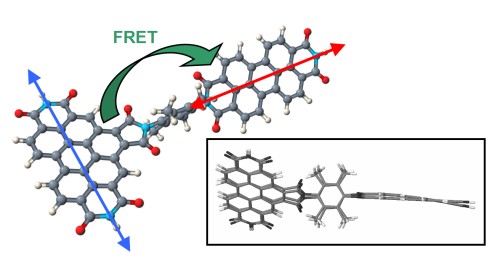Förster Resonant Energy Transfer in Orthogonally Arranged Chromophores
05-Nov-2010
J. Am. Chem. Soc., 2010, 132, 16777-16782 published on 05.11.2010
J. Am. Chem. Soc.
We investigate the ultrafast resonant energy transfer of a perylene bisimide dyad by pump−probe spectroscopy, chemical variation, and calculations. This dyad undergoes transfer with near-unit quantum efficiency, although the transition dipole moments of the donor and acceptor are in a perfectly orthogonal arrangement to each other in the equilibrium geometry. According to the point dipole approximation used in Förster theory, no energy transfer should occur. Experimentally we do, however, find an ultrafast transfer time of 9.4 ps. With the transition density cube approach we show that in the orthogonal arrangement the Coulombic interactions do not contribute to the electronic coupling. Through the change of the spacer in both length and chemical character, we can clearly exclude any Dexter-type energy transfer. The temperature effects on the Förster resonant energy transfer rate demonstrate that energy transfer is enabled through low-frequency ground-state vibrations, which break the orthogonal arrangement of the transition dipole moments. The dyads presented here therefore are a first example that shows with extreme clarity the decisive role vibrational motion plays in energy transfer processes.



